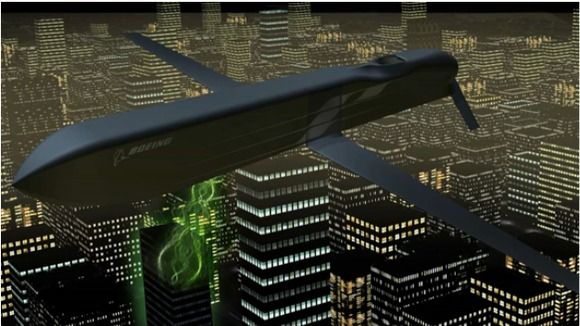Iraqi militia forces debuted an unmanned ground combat vehicle this week — but was it really invented by two nameless Iraqi brothers?
Category: drones – Page 158

Boeing Unveils Amazing, Slightly Terrifying New Electromagnetic Pulse Weapon — The Motley Fool
With pinpoint accuracy, this electronic warfare drone can black out opposing forces at will.
Boeing’s “CHAMP” (Counter-electronics High-powered Microwave Advanced Missile Project) is a one-missile, flying blackout. Image source: Boeing.
Video Friday: Russian Android, Swarm User Interface, and Robot Drone Man
Your weekly selection of awesome robot videos.
A Bird’s Eye View Courtesy of Virtual Reality
Check out the world from a drone’s perspective.

Drone receives wireless power, on the fly
Given that the battery life of most multicopter drones typically doesn’t exceed 30 minutes of flight time per charge, there are many tasks that they simply can’t perform. Feeding them power through a hard-wired tether is one option, although that only works for applications where they’re hovering in place. Scientists at Imperial College London, however, are developing an alternative – they’re wirelessly transferring power to a drone as it’s flying.
For their study, the scientists started with an off-the-shelf mini quadcopter. They proceeded to remove its battery, add a copper coil to its body, and alter its electronics.
The researchers also built a separate transmitting platform that uses a circuit board, power source and copper coil of its own to produce a magnetic field. When placed near that platform, the drone’s coil acts as a receiving antenna for that magnetic field, inducing an alternating electrical current. The quadcopter’s rejigged electronics then convert that alternating current to direct current, which is used to power its flight.


Verizon trials drones as flying cell towers to plug holes in internet coverage
Verizon has joined the likes of Facebook, Google and fellow telecommunications giant AT&T in exploring the potential of internet-connected unmanned aircraft. While its vision involves expanding 4G coverage across the US, it has an immediate focus on shoring up communications for first responders in emergency situations, and recently carried out trials to that effect.
Verizon has dubbed the initiative Airborne LTE Operations (ALO) and says it has actually been in the pipeline for around two years. The company has been working to integrate internet connectivity into unmanned aerial vehicles and hook them up to its 4G network, daisy chaining coverage and beaming it down to unconnected areas in the process. This is similar to how Facebook hopes its Aquila drones will work.
Verizon recently teamed up with company American Aerospace Technologies to see how using drones as gliding cell towers could have an impact in disaster relief scenarios. In a simulated mission in New Jersey, the team set a drone with a 17-foot (5.2 m) wingspan in flight to put the onboard technologies through their paces.

Project Originally Funded By DARPA Seeks To Replace Bees With Tiny, Winged Robots
Got a bee shortage? No problem, DARPA has you covered.
Following the news that the honeybee is now officially an endangered species as “colony collapse disorder” accelerates, it seems that a Harvard research team has the solution – robotic honeybees. Instead of attempting to save the bees by reducing the use of pesticides or revising safety standards for cell phone radiation, the focus has shifted to replacing the bees altogether. Harvard University researchers, led by engineering professor Robert Wood have been tweaking “RoboBees” since their initial introduction in 2009. The bee-sized robots made of titanium and plastic represent a breakthrough in the field of micro-aerial vehicles. The size of the components needed to create flying robots were previously too heavy to make a such a small structure lightweight enough to achieve flight. Current models weigh only 80 mg and have been fitted with sensors that detect light and wind velocity.
Researchers claim that the bees could artificially pollinate entire fields of crops and will soon be able to be programmed to live in an artificial hive, coordinate algorithms and communicate among themselves about methods of pollination and the locations of particular crops. In addition, RoboBees have been suggested for other uses including searching disaster sites for survivors, monitoring traffic, and “military and police applications.” These applications could include using RoboBees to “scout for insurgents” on battlefields abroad or allowing police and SWAT teams to use the micro-robots to gather footage inside buildings.
The RoboBees project originally began at the University of California at Berkeley in 1998 when neurobiologist Michael Dickinson, electrical engineer Ron Fearing, and then-grad student Rob Wood received a $2.5 million grant from DARPA to create an insect drone. Dickinson now continues his work at the University of Washington while Wood heads the principal RoboBee micro-robotics lab at Harvard. DARPA, the Defense Advanced Research Projects Agency of the US military, is best known for its role in helping create the internet, but a vast majority of their taxpayer-funded projects paint a decidedly dystopian picture of humanity’s future. Most of DARPA’s projects involve transhumanism, the merging of humans and machines to create a technologically governed populace.
The UK military wants your ideas for how to build swarms of attack drones
What’s that buzzing sound?
 Boeing’s “CHAMP” (Counter-electronics High-powered Microwave Advanced Missile Project) is a one-missile, flying blackout. Image source:
Boeing’s “CHAMP” (Counter-electronics High-powered Microwave Advanced Missile Project) is a one-missile, flying blackout. Image source: